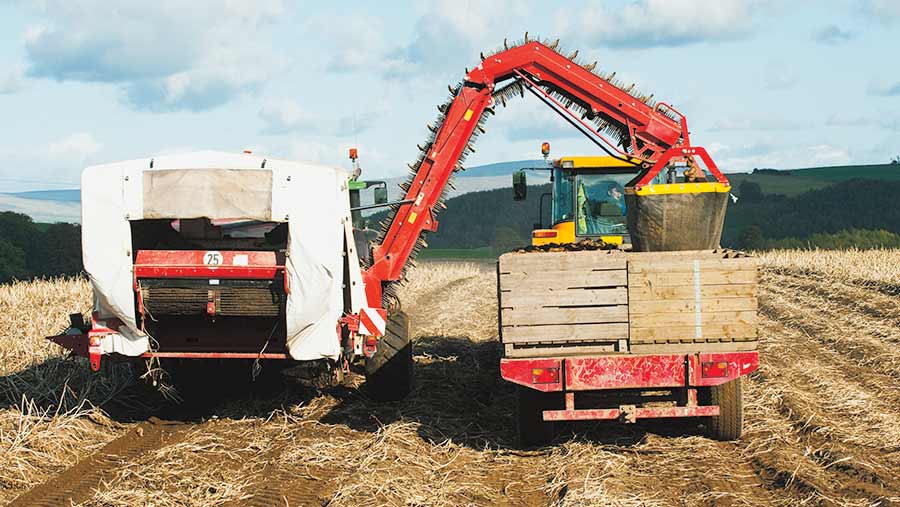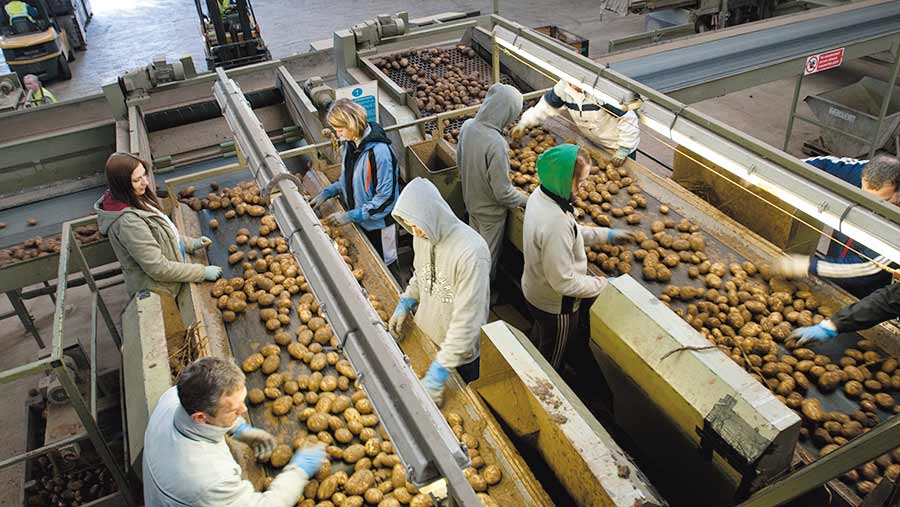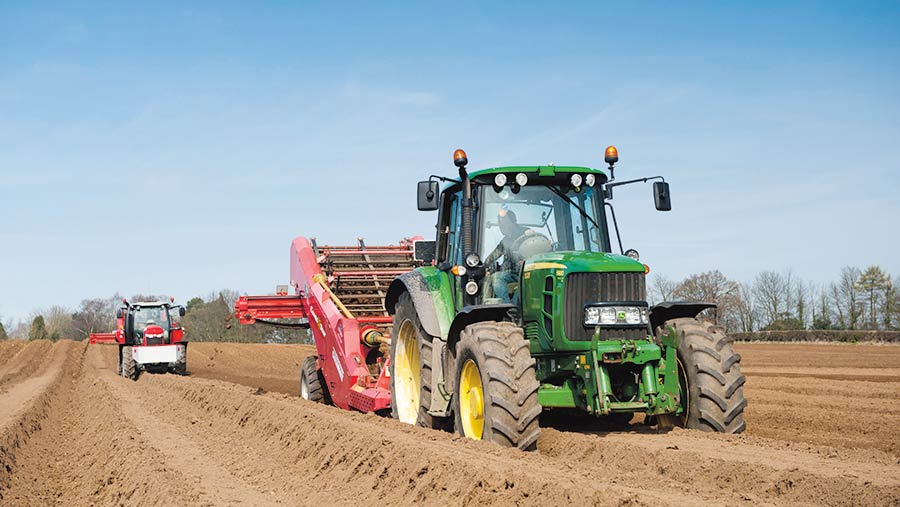Potatoes – should I stay or should I go?
 Potato harvest © Design Pics Inc/Rex/Shutterstock
Potato harvest © Design Pics Inc/Rex/Shutterstock Increasing specialisation in the potato sector, combined with tight margins, continues to prompt some growers to reevaluate the crop’s future. Farmers Weekly examines the issues to consider before making the decision to “stay or go”
Since the 1960s there has been a dramatic decline in the number of potato growers in the UK as production has become concentrated among fewer, larger growers who are better able to cope with the tight margins across the sector.
The “stay or go” decision is a complex one to make. Getting bigger is not necessarily the answer to remaining in the sector.
This is especially the case if expansion means a higher fixed-cost base in the form of additional storage, land, labour or equipment.
Some growers may be better off restructuring the business and letting land and/or storage to a specialist grower in order to concentrate efforts elsewhere.
See also: A guide to reducing tuber bruising losses this potato harvest
Price, marketable crop yield and fixed-cost structure are the main drivers of rationalisation and are the three areas that anyone considering their future in the sector needs to focus on, says independent potato consultant David Almond.
“Failure to perform in any one of these areas makes any potato business very vulnerable, given the slim margins,” he says.
Price
Price pressure has increased across the whole sector and growers can no longer afford to wait for a “good year” to compensate for periods of poor prices, Mr Almond says.
“Some growers still work firmly on spot markets, which is a gamble requiring deep pockets and a strong balance sheet, given the huge investment in the crop and risk involved in growing it.”
With total costs (fixed and variable) of £6,000-7,000/ha and potentially 12-18 months between making an investment in the crop and receiving a return from sales, cash-flow is a big consideration in the “stay or go” debate, says independent consultant Andy Alexander.
Add in the vagaries of the weather and consumer buying patterns and it is clear that growers have to be committed to the crop, with good financial resources, he says.
“Whatever market you are supplying, it’s still ultimately driven by what the general public want and there is huge pressure from retailers trying to capitalise their market share.”
Selling crops on contract gives some security over pricing and improves budgeting. “Nine times out of 10 it will be the right thing to do, but remember there may be certain end-user requirements that have to be met when growing for specific markets.”
Mr Almond says risk is a huge element in growing potatoes and needs to be taken into account when weighing up the options. “Deciding whether to take all the risk of growing, harvesting and storing the crop yourself or whether to share risk – or remove it entirely – is very much a personal choice.”
It is not a decision to make alone, though, and he encourages anyone considering their future in potatoes to speak to as many people as possible, including other growers.
UK potato facts
- Between 1960 and 2014, AHDB Potatoes figures show, the number of growers fell from about 75,000 to just over 2,100
- Producers who remain in the rationalised sector are growing ever-larger areas – the latest figures suggest growers with more than 100ha of potatoes account for more than half of the total planted area, almost double the proportion in 1999.
- The area planted reached a record low of 111,000ha in 2015 – a fall of 7.8% on the previous year’s area.
- Provisional figures show a 4% improvement in 2016 plantings, but the GB area of 116,000ha is still the second-lowest on record.
- An above-average yield of 46.8t/ha is needed in 2016 to maintain production at the same level as last year’s high-yielding crop, which averaged 48.8t/ha.
- The industry five-year average yield (including 2012) is 45.2t/ha.
Marketable yield
While price and yield are big drivers of production costs per tonne, the focus has to be on marketable yield, which is key to profitability, says AHDB Potatoes technical executive Phil Bradshaw.
This means getting the optimum proportion of the crop within the requested specification demanded by the end-user. A number of factors determine marketable yield, such as planting date, seed size, nutrition, soil type and weather.
Growers need strong technical knowledge and must be clear on the market they are supplying, what quality is required and whether that can be regularly delivered from existing resources (land, labour and machinery), Mr Bradshaw says.
Of particular importance is the question of whether contract pricing is structured in a way that delivers a profit in both good and bad seasons, he adds.
“You simply can’t compromise on quality and have got to meet the specification, whether that’s coming straight off the field or after six months’ storage. If you can’t achieve good quality consistently, then be sensible about the market you’re trying to target.”
As buyer demands change and requirements become more exacting, the technical expertise required across all aspects of crop agronomy and marketing is increasing, Mr Alexander says.
This may require improvements to training and technical skills of existing staff, and/or the use of specialist advisers familiar with market requirements, modern varieties and crop agronomy.
Investment in equipment or storage facilities may be needed to meet some end-user standards and new regulations (eg, CIPC sprout suppressant rules), so this must be factored into plans, he adds.
“Demands on quality and food safety are key factors that cannot be ignored. Growers have to stay abreast of what’s happening and be prepared to move with the times.”
Cost structure
A high level of fixed costs, principally those associated with labour and machinery, is the main cost-structure issue in many potato-growing businesses.
Often the need to replace or upgrade ageing stores or machinery hastens growers towards making a “stay or go” decision, Mr Almond says.
He acknowledges it can be hard to accurately allocate fixed costs where potatoes are grown alongside other enterprises, but he urges growers to try to do so – and to be honest when costing aspects such as own/family labour and depreciation.
The AHDB Arable Benchmark model (http://potatoes.ahdb.org.uk/online-toolbox/business-improvement) is an online tool to help growers benchmark financial and crop performance against industry data.
Spreading fixed costs over a larger cropped area may be one way of addressing a high cost base, but Mr Almond says growers must be cautious when doing so, especially as exposure to risk is increased.
Recent Defra data showed that the largest farms have the biggest liabilities, not only in absolute terms but also on a per-hectare basis.
“Getting bigger doesn’t necessarily mean you have a low cost structure. Scale must be appropriate to the capital invested. The land base and infrastructure must also be able to deliver the yield and quality required.”
Variable costs are slightly easier to manage, although soil-borne diseases such as potato cyst nematode (PCN) are an increasing issue in many areas and can significantly push up costs where control is required, Mr Bradshaw says.
PCN populations can be a big unknown when taking on new land, and management of the problem is forcing many growers to extend rotations from five or six to seven or eight years. “It’s a long time for land to be out of potato production, so needs to be considered in any decision,” he adds.
Consider business options
Mr Alexander advises growers to conduct a risk assessment of their own business, identifying the strengths, weaknesses, opportunities and threats.
All staff should be involved in the process, as they are often closest to the daily operations and may be able to highlight areas for change, he notes.
There are a number of alternatives for potato growers to consider when making the “stay or go” decision:
Continue growing potatoes in-house
- Take on all the risk and all the reward
- Ensure a sustainable business structure is in place – financially and environmentally
- Be clear on long-term aims
- Assess physical and financial performance and present/future working capital required to address any issues
Outsource operations
Reduce overheads and direct involvement with daily management in various ways, such as:
- Share/contract farming agreement with others
- Rent storage
- Use contractors for planting or harvest operations
Lease land/storage/irrigation to another specialist grower
- Demand depends on quality of resources available (including presence of soil-borne diseases) and location
- Consider the impact if demand drops, and land and storage proves more difficult to let
- A seasonal land let may be a simpler option than a complex contract farming agreement – rental income is classed as farm trading income for tax purposes.
Wholesale exit from potato growing
- The last resort, but may be worthwhile
- Consider financial and other implications for farm business (crop rotation, alternative use of resources, etc)
Tax implications of quitting
Any grower considering leaving the sector must evaluate the tax implications of doing so, the main one being the tax on machinery sales, says Newark-based accountant Mark Chatterton of Duncan & Toplis.
“Wherever capital allowances [eg, Annual Investment Allowance] have been claimed on this equipment, there will be a taxable profit or balancing charge to pay when it is sold.
“You need to understand what the tax liability will be before making any decision, which requires an accurate valuation of all equipment.
Even an old piece of kit dragged out of the nettles might go for more than you expect, so it’s worth getting someone out to value everything properly.”
Care should also be taken with the timing of machinery sales to mitigate the tax liability in any one financial year, he adds.
In some cases, it may be better to spread equipment sales over two or three financial years, rather than selling everything in one go.
New rules allowing profits to be averaged over five years for tax purposes may help spread any tax bill, Mr Chatterton notes.
Questions to ask
- What is the motivation for growing potatoes and the long-term business objective?
- Do you enjoy the technical challenge?
- How much risk do you want to take?
- What are your own strengths and assets? Have you the desire, confidence, technical knowledge, equipment and other resources (eg, land, buildings, labour) needed to grow a crop that is becoming increasingly specialised?
- Is there a successor keen to take on potato growing? Do they have the passion or technical knowledge required?
- Is it possible to manage costs and increase output sufficiently to make the crop viable at low prices?
- Does machinery or buildings need upgrading/replacing? Can the investment be justified?
- How could you manage the rotation without potatoes? Are the alternatives any more profitable?
- How can existing resources be redeployed? Is it possible to generate other income from the land, irrigation capacity and storage? Will these be any more profitable?
Case study: Billockby Farms, Norfolk – three-pronged approach to profitable potatoes
Potatoes remain a profitable part of the rotation at Billockby Farms near Great Yarmouth, Norfolk, where 221ha is grown annually in rotation with 2,000ha of mixed arable crops, including wheat, barley, sugar beet, peas and forage maize.
Farms director Henry Alston says careful cost management, risk mitigation and maintaining a close working relationship with their buyer are the three key elements to ensuring the processing crop has a viable future.
“I look at potato production in terms of machinery and labour units. We own all our equipment and have a number of different irrigation systems on the farms involved.
Everything is carefully recorded as it’s essential we make the most efficient use of the resources available and are realistic as to what we can achieve in terms of yield and quality.”
About 85% of the crop is contracted on a three-year agreement with their buyer and Mr Alston aims for an average marketed yield of 50t/ha.
A mix of five varieties (Shepody, Innovator, Russet Burbank, Maris Piper and Pentland Dell) is in the ground this season to help spread the inherent risks associated with growing, harvesting and marketing the crop.
“Variety choice is guided by discussions with the processor, but the final decision is a joint one made by our technical adviser and myself that is specific to individual fields.”
Lifting of early-maturing varieties usually starts around the end of July, while maincrop will be lifted from mid-September. “Half of our total crop is moved straight off the farm at harvest, while the other half goes into long-term storage.”
This helps manage risk and spreads cashflow into the business, says Mr Alston.
“There are downsides to growing potatoes, which are often beyond our control, but there are upsides too and for us it remains a profitable crop. It’s about how you mitigate the downsides.
“There’s no doubt that there’s a finite availability of quality land with the infrastructure required for growing potatoes, so our fall-back will always be what we could rent our infrastructure to a third party for in order to grow another crop.”
Release capital by leaving
Poor profitability, change in family leadership and/or a need to reinvest in machinery or fixed equipment are the three most common reasons for growers quitting in-hand potato production, according to Nick Blake from farm business consultancy Andersons Eastern.
For almost all businesses, the catalyst is either one or a combination of these factors, says Mr Blake, who together with colleague Jay Wootton has worked with a number of clients who have reviewed their potato enterprises.
Every case is different, but it is often growers with smaller areas, typically 60ha or less, that decide to stop production and in many cases it is the introduction of a younger generation into the business with a different attitude to risk that prompts the “leave” decision, he says.
“Most (if not all) growers have not regretted the decision to give up production.”
Letting land and storage to a third party is the most popular option for those who decide to leave, so owner-occupiers with their own storage have most to gain, he says.
Rents vary considerably, depending on the quality of land, storage and irrigation available, but are typically in excess of £740/ha (£300), with box storage at more than £25/tonne, excluding box hire and electricity.
The letting option works best if both parties are willing to commit for a number of years and take a block of land that either equals or exceeds the store capacity.
The main benefit for businesses deciding to cease potato production is to release working capital, typically worth more than £4,900/ha.
Reducing risk, more free time, and an opportunity to restructure the business by not replacing retiring members of staff are other benefits, he says.
Agreements usually take the form of a cropping licence for land, with stores on a lease or informal handshake, says Mr Blake, who suggests growers should consider a three-year deal.
“It takes a change in attitude to be comfortable with other businesses operating on land and in farmyards. For many it will be a new experience and one they are not entirely comfortable with.
“Sometimes there are opportunities for landowners to provide services to the grower. This could be irrigation, spraying, cultivations or providing labour at harvest, such as handling in/out of the potato store.”
Marginal land (eg, not producing the yield or quality due to soil type, PCN or water availability) can be more challenging to let as growers become more selective and water becomes a priority, so local demand must be factored into any exit calculations, Mr Blake says.
Some may opt to replace potato production with alternative cropping.
However, he says this generally requires a more radical restructure of overheads and is reliant on the alternative being more profitable than potatoes to be successful.
“It is more difficult to justify leaving at a time when commodity markets are low, so people tend to stay in until other crop profitability improves.”



